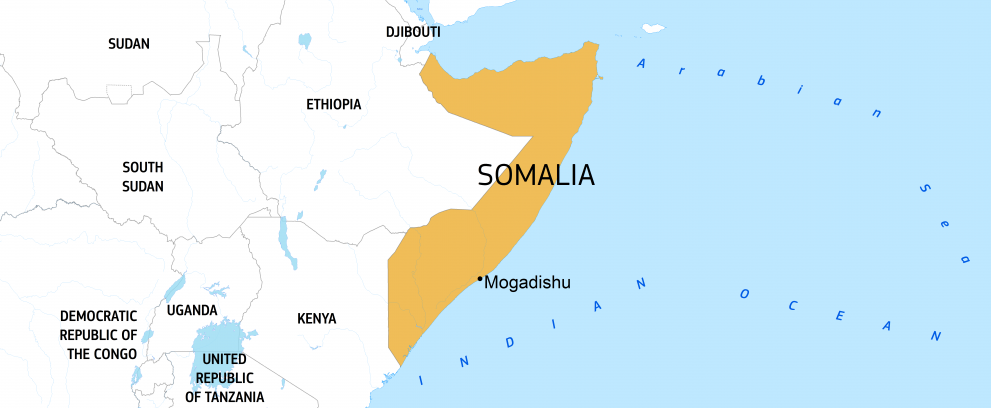Introduction
For decades, Somalia has endured prolonged conflict and extreme weather conditions.
The recent drought has led to 90% of the country being under extreme drought conditions. 5 consecutive rainy seasons have failed, impacting over 8 million people. Since 2021, more than 1.7 million have been displaced by the drought.
The latest Deyr rainy season (October-December 2023), aggravated by the El Niño effect combined with a positive Indian Ocean Dipole, translated into above-average rainfalls and massive flooding, and affected 2.5 million people, including 1.2 million people who were forcibly displaced and 119 casualties.
Extreme weather events driven by climate change are compounded by conflict, political instability, COVID-19, and the impact of the war in Ukraine on food, fuel, and fertiliser prices.
What are the needs?
In 2024, at least 6.9 million people, almost half of Somalia’s population, require immediate life-saving humanitarian and protection assistance.
While famine is no longer the most likely scenario, food insecurity remains high, with more than 4.3 million people still acutely food insecure, and about 1.5 million children under the age of 5 expected to suffer from acute malnutrition in 2024.
More than half of the population is water insecure, while 4.6 million people need shelter and non-food items. In addition, Somalia ranks last place in the Global Health Security Index, and 80% of households lack a handwashing facility.

Currently, there are close to 4 million internally displaced people in Somalia due to drought, floods, conflict, and insecurity. They live in unsanitary makeshift camps, facing increased protection and health risks.
Since 2022, protracted armed conflict with renewed large-scale fighting has severely impacted civilians and the movement of people and goods in the country. Violations of international humanitarian law are widespread.
Despite increasing aid support since August 2022, humanitarian needs still outpace the response. The 2023 Humanitarian Response Plan for Somalia, which sought more than US$2.6 billion to meet the priority needs of 7.6 million people, had only 43.6% of the requested funding secured at the end of 2023.
Therefore, increased humanitarian assistance is needed to respond to the number of overlapping crises and prevent deaths.
The 2024 Humanitarian Needs and Response Plan for Somalia requires US$1.6 billion to meet the priority needs of the 5.2 million people targeted.

How are we helping?
For 2024, EU humanitarian funding has an initial available budget of €37 million for humanitarian interventions in Somalia. In 2023, the EU allocated €85.3 million for humanitarian projects in Somalia, mainly in response to the drought.
EU humanitarian funding supports aid organisations in delivering (i) food assistance, (ii) basic health and nutrition services, (iii) clean water, (iv) protection, (v) shelter, and (vi) education.
Our humanitarian partners work in rural and hard-to-reach areas to ensure no one is left behind. They also work to mitigate further displacement of rural populations while also providing essential lifesaving assistance in already congested urban and peri-urban areas hosting those displaced.

Whenever relevant, EU humanitarian support helps people in need through cash transfers. This enables them to feed and sustain their family while also meeting other basic needs in a dignified way. Using cash transfers also helps overcome accessibility challenges while supporting local markets.
Somalia has high child and maternal mortality rates, severe malnutrition rates, and frequent outbreaks of disease. The country’s health system also faces critical shortages, and only 1/3 of health facilities are functional.
There is currently an increase in outbreaks of disease in the country, especially acute watery diarrhoea, cholera, and suspected measles. This is due to climate shocks, limited access to clean water and hygiene, and unsanitary living conditions in displacement camps. All these diseases are potentially deadly.
Therefore, the EU focuses on providing quality health care, epidemic prevention and control, and emergency treatment of malnutrition. We support experienced health and nutrition partners in communities and health facilities.
In July 2022, the EU launched a Humanitarian Air Bridge to deliver emergency supplies to hard-to-reach areas no longer accessible by road. This operation transported life-saving nutrition and health assistance to underserved and hard-to-reach locations during the most critical dry period.
The EU also funds disaster risk reduction and preparedness activities through community-based early warning, preparedness, and response systems. The aim is to reduce the impact of the multiple shocks experienced in the country related to climate, conflict, and epidemics.
However, the country still needs more long-term development to support the resilience and self-reliance of the vulnerable, such as pastoral, agricultural and marginalised communities. Cooperation between the EU’s humanitarian and development actions is ongoing, especially for cash-based social safety nets and education, to build up the longer-term resilience of affected Somali communities.
The EU aims to increase the visibility of the crisis, such as through the High-Level Roundtable on the Horn of Africa Drought. This was co-hosted by Commissioner Lenarčič and UN Under-Secretary-General for Humanitarian Affairs and Emergency Relief Coordinator Martin Griffiths on 26 April 2022.
Last updated: 27/02/2024
Facts & figures
At least 6.9 million people need humanitarian assistance and
more than 4.3 million are acutely food insecure (OCHA)
1 in 8 children dies before turning 5 (UNICEF)
Close to 4 million internally displaced people (OCHA)
More than 714,000 Somali refugees in neighbouring countries (UNHCR)
EU humanitarian funding:
€37 million in 2024
€85.3 million in 2023
Around €220 million since beginning of 2021
Nearly €543 million since 2017

